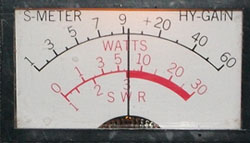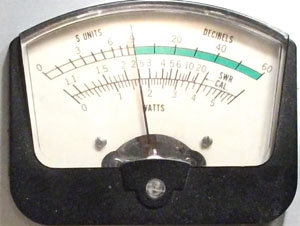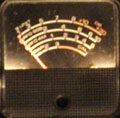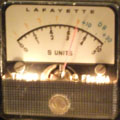

A Tribute to the "S" Meter
Ever since I saw my first radio with a signal meter, I knew I wanted one............
They come in all shapes and sizes. From the smallest mobile meter, barely 3/4 of an inch across.........

To the largest base station meter, over 3 inches wide.........

Some
swing from the bottom....  others from the top...
others from the top...  or
even the side...
or
even the side... 
Some
are white.............................  while others are blue.........
while others are blue.........  but we all know what they do......
but we all know what they do......
Hah! I didn't know I was a poet..... But yes, they all do the same thing, and that is measure your incoming signal. Yes, it's the S meter, we're talking about here, and this article is dedicated to them, in all their various shapes, sizes and colors!
The "S" (for Signal) meter has been a fairly standard feature on most CB radios, and one of the most interesting and useful options. A good S meter can help you when you are peaking a signal on a beam. It can help you track down a jammer. It can also help you judge just how much better that new antenna is over your old one, or how much better you're putting out with that 100 watt amplifier over a stock 4 watt signal. Yes, the S meter is a versatile tool, even if most CB S meters were not all that accurate or linear. Today, I almost take the S meter for granted. But in the beginning, it seemed as if I'd never get a radio equipped with one...........
When my friends and I first started out in radio, it was with very simple equipment, namely walkie-talkies. These radios were sparsely equipped, with few "bells and whistles". We were lucky to have a call signal or more than a single channel, or even a volume control. But I pretty much thought that this was as good as it gets. Sure, I knew there were more powerful radios out there, but I figured they were just bigger versions of what I already had. I never imagined the sheer amount of extra frills which could be had. From Tone controls, to R.F. gains, to Delta tunes, and even a Squelch. But I would eventually learn about all of them as I slowly became exposed to different makes of radios, and obtained radio catalogs. But the neatest feature of them all, and the one which I just had to have, was the Signal (or "S") meter. But it would be the one feature which seemed to elude me for a couple more years to come, hovering out there just out of reach on those radios which I could see in catalogs and occasionally touch, but couldn't yet posses. But like they say, good things come to those who wait..........
![]()
For me, the story began back in 1972. While I had made myself at home with the local group in my neighborhood back then, the people who I talked to (who could actually hear me) would occasionally tell me what I was "giving them" when I would ask how I was coming in. One said that I was an "8", and another said barely a "5". I didn't understand what they were referring to so I asked them to explain. I was told that their radios had "S" (for signal) meters which could read incoming signal strength. Oh really? I had always known you could tell stronger signals from weaker ones by how strong they sounded, but I never knew there was a way to actually measure it, let alone display it on a meter. I thought that was the coolest thing ever. Then again, it didn't take much to impress a 12 year old just starting out on his radio journey. But from that moment on I knew I wanted to get a radio with an "S" meter on it and, in the meantime, perhaps there was a way to add one to my 100 mW base radio. Since my pitiful income potential pretty much kept the prospects of my obtaining a full-blown CB radio, to the "when pigs fly" status for the near term, I started looking for a way to add a meter to my radio. Unfortunately, I barely knew the difference between a resistor and a capacitor at that time, so I lacked the necessary theory to pull it off for real. But that didn't stop me from trying to McGyver something close. One of my electronic kit projects was a crude VU meter for measuring audio amplitude. So I found a way to adapt that to the speaker output of my radio. It sort of worked, as the stronger signals were usually louder as well, and they would therefore deflect the meter further over than a weaker station. But the meter fluctuated with voice peaks and was not a steady indication. But it was the best I could do at the time.

In 1973, a few of my friends managed to upgrade to 5 watt radios, like the Heathkit "Lunchbox", the Lafayette HB-115 and even a Utica Town & Country. While these were certainly more powerful than our walkie-talkies, they were still pretty much bare bones in the feature department, and they lacked that all-important "S" meter functionality, so I still didn't really know what I was missing. But then I got to operate Jimmy's Navaho Pro base station, and watching everyone's signal had an almost mesmerizing effect, especially when I was told that you could find people by homing in on their signal. That was both very interesting and also a bit frightening, especially when put into the context of our early FCC paranoia. My thirst for a radio with an S meter suddenly became an even greater priority, but my financial situation hadn't gotten much better in the past year.
By the middle of 1974, I had finally saved up enough money to buy up a nice Midland mobile radio equipped with a few nice features and, more importantly, my coveted S meter. But a perpetual out-of-stock situation, combined with a more intense desperation to get anything with a 4 watt output and 23 channels, meant that the radio I finally ended up with, as luck would have it, was a Pace 223, which did not have a meter (Rats!). It seemed like far longer, but I only ran the Pace for a little over 2 months, before more wheeling and dealing would finally land me my first radio with a nice sized S meter, the Lafayette Comstat 25. It took nearly 2 years (which seemed like a lifetime back then) from the time I first became aware of the S meter before finally getting my own radio equipped with one. But from then on there was no turning back. Naturally, once I got a hold of the prize, I became a serious meter watcher. I knew everyone's normal signal, not only the locals who shared my home channel, but also those on other channels. This became helpful when someone would decide to dump a carrier or otherwise agitate our group. A combination of a known signal along with a distinctive mic key up sound, was often all it took to betray the identity of the formerly anonymous, would-be jammer. My meter and I became close friends, and life was good until I picked up my second radio with an S meter, the SBE Cortez. It was then that I discovered that not all S meters were created equal. Even when the S9 signals were adjusted to read the same between both of my radios, the lower and higher signals didn't track the same. And when I got my next major radio, the Midland 13-885, there was yet another signal reading difference. Somehow I managed to mentally recalibrate everyone's signal reading on each of my radios. I'm surprised that I had the memory to keep it all straight back then. Where did that go?
But this brings up an important point, not all S-Meters are created equal. Most CB radio S-meters display S units from 1 to 9 and then in db's from +10 to +30. Some radios go to +40 or +60db. A truly calibrated S meter will increase 1 "S" unit for every 6db increase in signal. However very few radios will track that linearly. Even when set for an S9 reading with a 50uV input signal, some will jump 1 "S" unit with only a 4 or 3db increase in signal. While others might take 7 or 8db. Still others will start out very generous on the low end, and then tighten up between S7 and S9. Some radios will peg the needle all the way to the stop (or the glass) when someone is within 1/4 mile, while other radios never seem to deflect beyond +10db over S-9, even if someone is sitting in your driveway with 200 watts running. I guess it should be no surprise that the most expensive, top of the line radios, like the Tram D201, the Browning Golden Eagle, and the Hy-Gain 623 have the most linear tracking S-Meters.
In the late 70's, the manufacturers started coming out with radios equipped with LED bar graph signal meters. Can you guess how I felt about those? If you said that I probably hated them, you're right on the money. Those LED meters lacked the fine resolution of an analog meter, and some only had 4 or 5 segments. That certainly wasn't enough granularity to get a precise signal reading. But the bar graph meters fit better on those ever shrinking mobile rigs, so in one way, it made sense. But to those manufacturers of larger base radios which were also equipped with LED meters, shame on you for cheapening out on an important feature.

As CB radio moved into the 21st century, not a whole lot has changed. There are still radios with LED bar graph meters and, thankfully, many more still sporting "old fashioned" analog meters. The very latest in technology utilizes fine pixel LCD screens to mimic the action of an analog meter. While this is certainly better than a limited segment bar graph meter, it's still not quite as fine a resolution as the mechanical analog meter, which still remains my favorite choice.
Having a preoccupation with the "S" meter is hopefully not something that was unique to me. Indeed, I have known people in the past who shared my almost OCD-like focus on other people's signals, and with the means to make it all happen. Most of those people did so for similar reasons, and I suspect they have chosen their favorite radios based, in no small part, on how well their S-meters functioned.
CB radios have had many useful and interesting features. Some of them truly enhanced performance. Others were little more than gimmicky bells and whistles. But in my humble opinion, the most useful and interesting accessory feature was the S-meter.